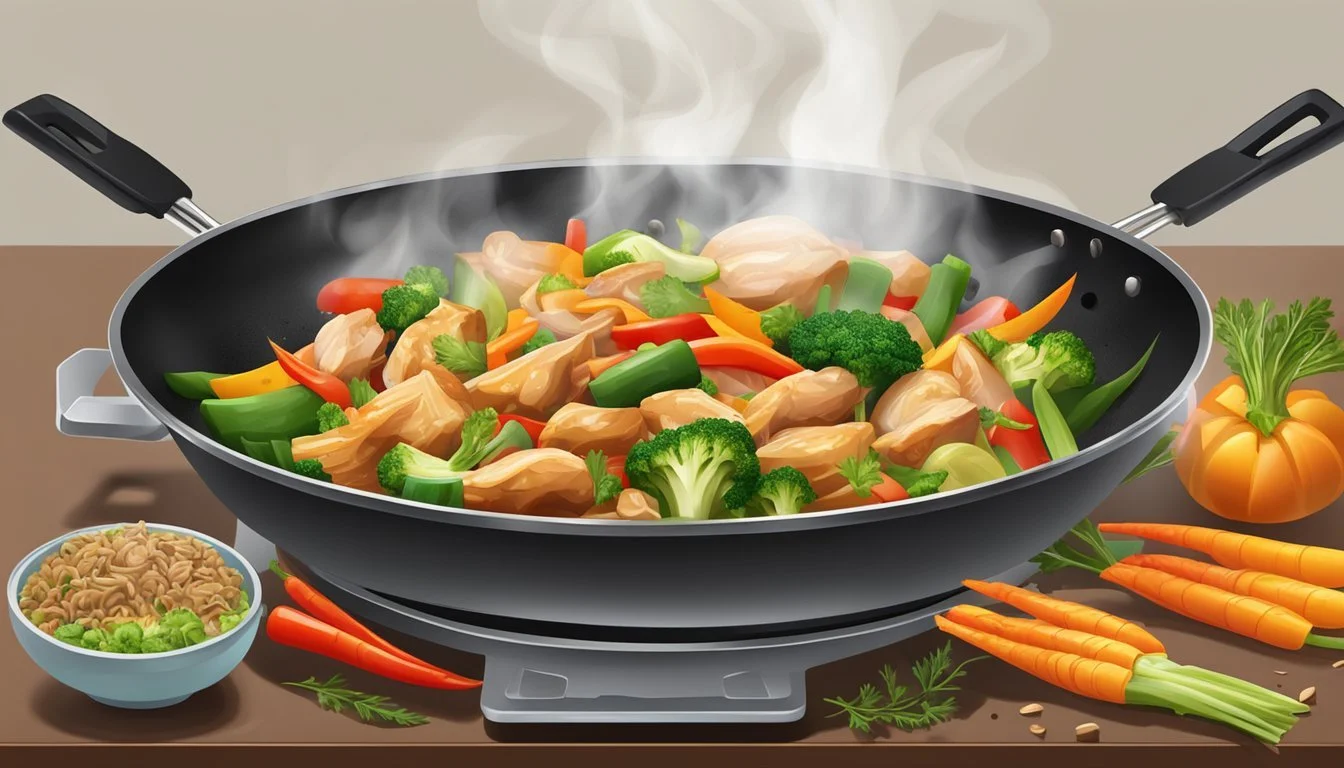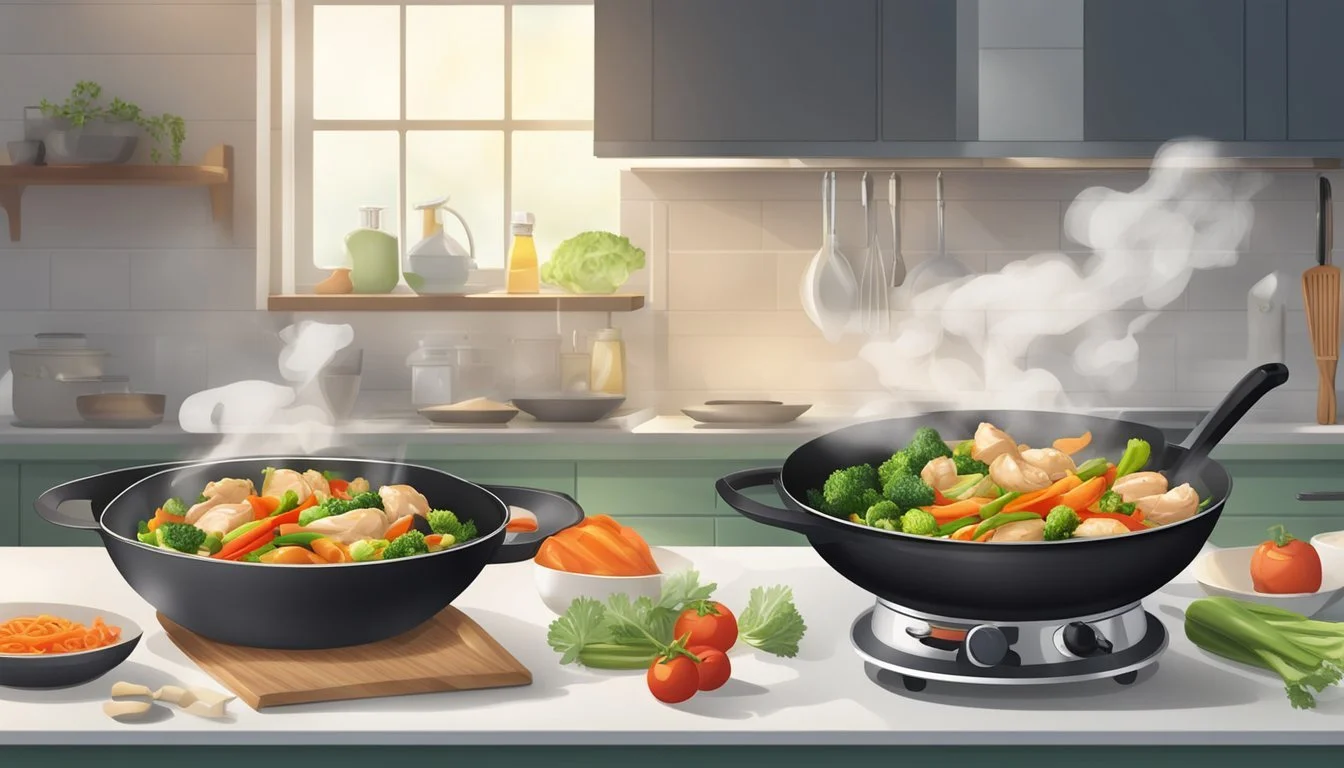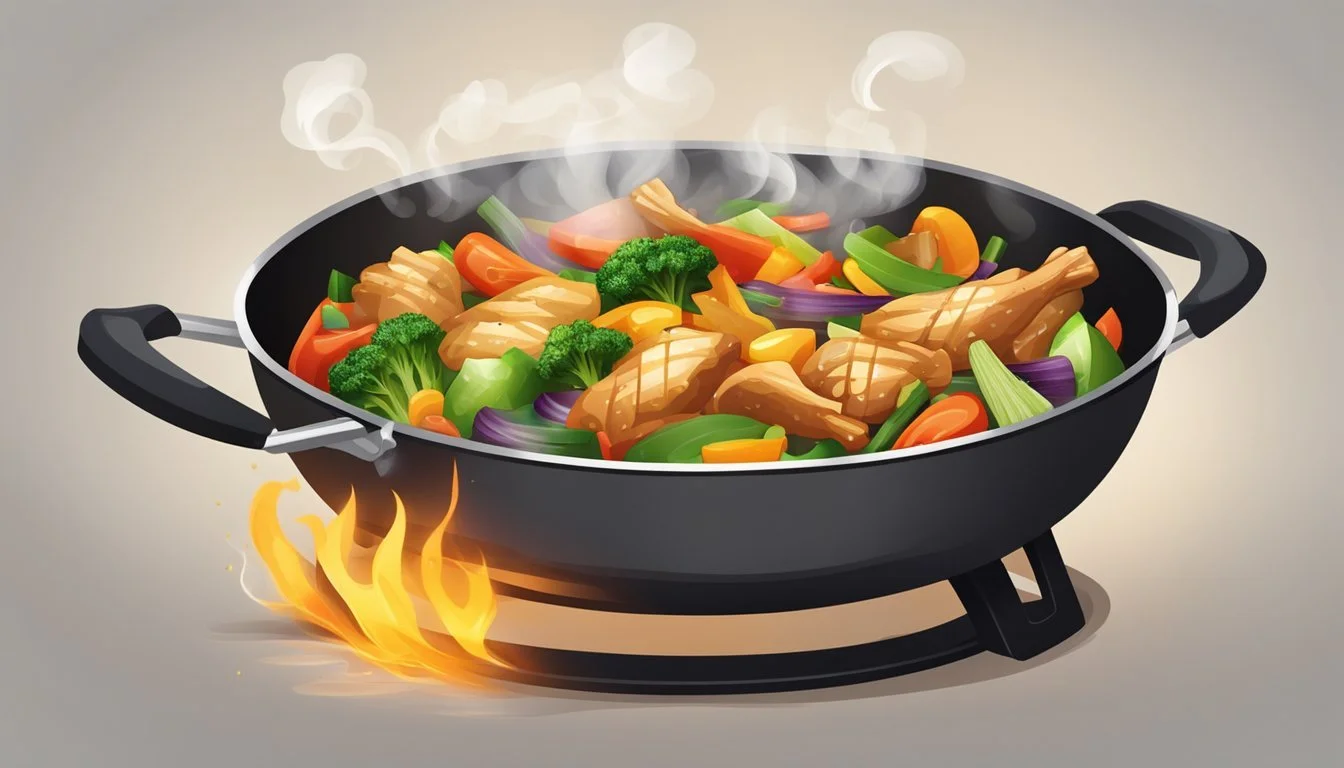How Long Does Chicken Stir-Fry Last?
Shelf Life and Storage Tips
Chicken stir-fry is a versatile and popular dish that's perfect for busy weeknights and quick lunches. This flavorful mix of chicken and vegetables can be a lifesaver when you have little time to cook. However, knowing how long it can safely last in the refrigerator is crucial to avoid any health issues.
Chicken stir-fry can generally be kept in the fridge for about 3 to 4 days if it is stored properly. To ensure it remains delicious and safe to eat, keep it in an airtight container. This not only retains its moisture but also helps to prevent bacterial growth.
For those who might not consume the stir-fry within this timeframe, freezing offers a good alternative. Proper food safety guidelines should always be followed when handling and reheating chicken stir-fry, guaranteeing a tasty and secure meal each time.
Understanding Stir Fry and Food Safety
Stir fry, a popular dish typically combining chicken, vegetables, and sometimes other proteins, can be prone to bacterial growth and contamination if not prepared and stored correctly. Ensuring food safety involves specific practices to prevent food poisoning and other foodborne illnesses.
The Basics of Stir Fry
Stir fry usually contains ingredients like chicken, vegetables, and sometimes seafood or meat. These ingredients must be cooked at high temperatures to ensure the destruction of harmful bacteria.
Cooking chicken and vegetables evenly is crucial to avoid parts that might remain raw. The high heat used in stir frying not only cooks food quickly but also helps to maintain its texture and nutritional value.
Properly cooked chicken should reach an internal temperature of 165°F (74°C). This ensures that any bacteria present in the raw chicken are killed. Vegetables should be cooked until tender but still slightly crisp.
Food Safety Fundamentals
Food safety in stir fry begins with preventing cross-contamination. Raw chicken and other proteins should be prepared on a separate cutting board from vegetables. All utensils and surfaces that come into contact with raw chicken should be sanitized immediately after use.
When storing stir fry, it should be cooled quickly to prevent the rapid growth of bacteria. Place leftovers in shallow containers and refrigerate within two hours of cooking. Stir fry can last in the fridge for 3 to 4 days if stored properly. Always reheat to an internal temperature of 165°F (74°C) before consuming.
Freezing is another option if you don’t plan to eat the stir fry within a few days. Thaw frozen stir fry in the refrigerator and reheat until steaming hot. Following these food safety practices ensures a delicious and safe meal every time.
Proper Storage Techniques
Proper storage is essential to maintain the freshness and safety of chicken stir-fry. Learn about the best practices for refrigerating leftovers and freezing for longevity.
Refrigerating Leftovers
Leftover chicken stir-fry should be stored in an airtight container to preserve its freshness and prevent contamination. Place the stir-fry in the container once it has cooled to room temperature. It is essential to refrigerate leftovers within two hours of cooking to reduce the risk of bacterial growth.
Maintaining a fridge temperature below 40°F (4°C) is crucial. Keeping food in the back of the fridge can ensure a consistent, cool environment. Labeling containers with the date helps keep track of how long the stir-fry has been stored, ensuring that it is consumed within the safe period of 3 to 4 days.
Freezing for Longevity
For longer storage, chicken stir-fry can be frozen. Portioning the stir-fry into individual servings and using freezer-safe containers or heavy-duty plastic bags can simplify reheating later. Remove as much air as possible from the containers or bags to prevent freezer burn.
Before freezing, make sure the stir-fry is completely cooled to avoid condensation, which can affect the moisture content and overall quality. When stored properly, frozen stir-fry can last for up to 2-3 months. Labeling each container or bag with the date of freezing helps manage inventory and ensures the oldest items are used first.
Shelf Life Determinants
Chicken stir-fry can last for about three to four days in the refrigerator when stored properly. Factors such as temperature, ingredients, and storage methods significantly affect its freshness and quality.
Factors Affecting Freshness
The temperature of the refrigerator should be set at or below 40°F (4°C). Higher temperatures can lead to faster spoilage. Ingredients also play a crucial role; dishes with higher moisture content may spoil quicker.
Using an airtight container to store the stir-fry helps maintain quality by reducing exposure to air and moisture. Ensuring the internal temperature drops to a safe level quickly also prevents bacterial growth. Proper handling and using fresh ingredients further extend the shelf life.
Identifying Spoilage
Odor is a key indicator; spoiled stir-fry often has a sour or off smell. A slimy texture on the chicken or vegetables suggests bacterial growth. Discolored spots or visible mold growth are also signs of spoilage.
Checking for these signs before consuming leftovers is crucial. If any signs of spoilage are present, it's safer to discard the stir-fry. This practice helps avoid foodborne illnesses and ensures a safe dining experience.
Reheating and Consumption
Chicken stir-fry can retain its flavor and texture if properly reheated. The keys are choosing the right method and reheating to an appropriate temperature.
Methods to Reheat Stir Fry
Stovetop/Wok
Use a wok or skillet over medium-high heat. Add a small amount of oil to prevent sticking. Stir occasionally as it reheats to ensure even warming. This method helps keep vegetables crisp and maintains the dish's texture.
Microwave
Place the stir fry in a microwave-safe dish and cover with a paper towel. Reheat on medium power for 90 seconds. Stir midway through to distribute heat evenly. This method is quick but may soften vegetables and dry out proteins.
Oven
Preheat the oven to 350 degrees Fahrenheit. Place the stir fry in an oven-safe dish and cover with foil to prevent drying out. Heat for about 10-15 minutes, checking periodically until evenly heated.
Air Fryer
Set the air fryer to 350 degrees Fahrenheit. Place the stir fry on a sheet of aluminum foil and cook for around five minutes, stirring midway. This method can retain crispiness but may not heat as evenly.
Ensuring Pleasurable Eating Experience
Proper storage is crucial. Store stir fry in an airtight container in the fridge for up to 3-4 days. Reheat only what will be consumed to avoid repeated reheating, which can degrade quality.
Use fresh ingredients for the initial preparation to maximize reheated meal quality. Avoid overcooking during reheating by monitoring time and temperature closely.
Add a splash of soy sauce or fresh herbs after reheating to revive flavors. Combining proper storage, appropriate reheating methods, and small flavor adjustments ensures a satisfying meal every time.
Additional Considerations
Storing and managing chicken stir-fry correctly involves understanding meal prep strategies, thawing frozen stir fry properly, and labeling containers for easy tracking.
Meal Prep and Batch Cooking
Meal prep and batch cooking can save time. When preparing chicken stir-fry, consider portioning meals into individual servings. Use airtight containers to maintain freshness.
Include a mix of protein like chicken, a variety of vegetables, and either noodles or rice.
Ensure everything is cooked thoroughly and cooled before storing. Food safety guidelines recommend storing cooked stir-fry in the refrigerator within two hours to prevent bacterial growth. Remember, stir-fry typically lasts 3-4 days in the fridge.
For longer-term storage, you can freeze stir-fry. Properly stored in airtight containers, it can last up to 2-3 months.
Properly Thawing Frozen Stir Fry
Thawing frozen stir-fry needs to be done carefully. The safest method is to transfer the container from the freezer to the refrigerator and let it thaw overnight.
Avoid leaving it at room temperature, as this can lead to bacterial growth.
Quick defrosting options include using a microwave or placing the container in a sealed bag submerged in cold water. Cold stir-fry might not taste as fresh, so ensure it is reheated thoroughly before consuming.
It's crucial to check that the temperature reaches at least 165°F (74°C) to ensure safety.
Labeling and Keeping Track
Proper labeling is essential for keeping track of stored meals. Clearly mark each container with the type of stir-fry, the date it was cooked, and the date by which it should be consumed.
Use labels that can withstand freezing conditions if you plan to store them in the freezer.
Keep a log or a simple chart on the refrigerator door to track older meals. This helps prevent waste and ensures you consume dishes within their safe time frames.
Following these practices helps maintain the quality and safety of your chicken stir-fry.
Ingredients Specifics
The shelf life of chicken stir-fry largely depends on the types of ingredients used, such as various meats, vegetables, and sauces. Each element can affect how long the dish remains safe to eat.
Influence of Different Ingredients on Shelf Life
Chicken and other meats like shrimp and beef should be fresh and properly cooked to ensure a longer shelf life. If not, they can quickly spoil and shorten the dish's usability. Chicken generally holds well for about 3 to 4 days in the fridge.
Vegetables like carrots, asparagus, and broccoli florets can impact longevity. Fresh, crisp vegetables tend to last longer. Conversely, garlic can start to lose its flavor and texture after a couple of days.
The choice of sauces is also crucial. Soy sauce, oyster sauce, and sesame oil are relatively stable but can alter the texture of the dish over time. Chicken broth or other broths tend to have a shorter shelf life and can affect the overall lasting duration of the stir-fry.
It is crucial to store stir-fry in airtight containers and at a consistent refrigerator temperature to maximize shelf life. Generally, stir-fries with various sauces and fresh ingredients are best consumed within 3 to 4 days.
Health and Nutritional Insights
Chicken stir-fry combines a variety of nutritious ingredients like vegetables, lean meat, and minimal oil usage. Its nutritional benefits are best enjoyed when fresh, and proper storage can prevent food waste.
Nutritional Value of Stir Fry Ingredients
Chicken stir-fry often includes lean protein from chicken and a mix of vibrant vegetables such as bell peppers, broccoli, carrots, and snow peas. Chicken is a rich source of protein, essential for muscle repair and growth. Vegetables in stir-fry add vital vitamins, minerals, and fiber to the dish, promoting overall health. Stir-frying uses minimal oil, which helps keep the calorie count low. According to the USDA, these ingredients collectively provide a well-balanced meal that supports a healthy diet.
Avoiding Food Waste
Proper storage of chicken stir-fry can extend its shelf life and reduce food waste. The USDA recommends storing cooked stir-fry in the refrigerator for up to four days in an airtight container to maintain freshness. If it's not consumed within this period, consider freezing the dish, which can preserve it for up to three months. Leftover stir-fry can also be repurposed into other meals like chicken noodle soup or salads, ensuring that leftovers are not wasted and continue to provide nutritional benefits. This practice not only saves money but also minimizes environmental impact.








